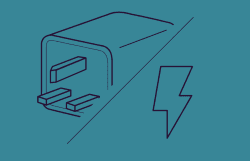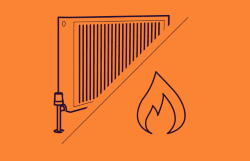What are microgrid projects and how do they work?
A microgrid acts as a stand-alone energy system used to provide power to a specific geographic area, such as a neighborhood, business district, hospital complex, or college campus. One or more types of distributed energy such as solar panels, wind turbines, combined heat or power plants, and generators are used in microgrids to generate power. In addition, a lot of more recent microgrids have energy storage, usually in the form of batteries.
A microgrid system can be connected to the national grid, but also works to reliably supply electricity at peak times across the UK to its chosen area. Local, independent and smart, the automatic power supply has the potential to be a cost effective investment for your home or business.
Based on variables like power reliability and cost effectiveness, intelligent software controls can automatically switch the facility between the main grid and the microgrid. You can learn how microgrids work here.
Who can request a micro grid?
Hospitals, data centres, and other sites where dependability and resilience are crucial were early users of microgrids. Today, businesses of all sizes are utilising distributed energy resources such as microgrids for their financial and environmental advantages towards sustainability.
If you are looking for a sustainable solution to your energy needs, introducing a microgrid is a small step to take in the long term. You can request quotes for microgrid installation through a number of sites including Sunstore.co.uk and cat.com.
How are microgrids regulated?
The size and purpose of the microgrid are just two of the many variables that affect how they are regulated. If microgrids meet specific requirements set forth by the Federal Energy Regulatory Commission, they may be free from the majority of federal and state regulations.
Exempt microgrids, often referred to as FERC-jurisdictional qualifying facilities, have the option to avoid certain rules that control rate setting, construction, and operation.
What are the setup costs of a microgrid system?
The cost of installing this system in the UK can vary widely depending on the size and complexity of the system, as well as the location and other factors. However, on average, the cost of installing a microgrid system in the UK can range from £50,000 to £500,000 or more.
Smaller systems that are designed to power a single building or a group of buildings typically cost between £50,000 and £200,000, while larger systems that are designed to power entire communities or industrial sites can cost hundreds of thousands of pounds or more. It is important to do research on how much you could save before you decide that this method will efficiently reduce your energy costs.
The cost of installing a microgrid system may include expenses such as equipment and installation costs, connection fees, engineering and design costs, project management fees, and financing costs. Businesses should conduct a thorough cost-benefit analysis to determine the financial feasibility of a microgrid system and explore financing options such as loans, grants, or lease agreements.
What do I need to have installed in order to get a microgrid on my property?
To make sure that you have the development potential to install the off-grid systems in 2023, please get in touch with one of the suppliers named above. Setting up a microgrid on your property can be a complex process, but there are a few essential components that you will need. Here are some of the things you will need to consider:
Power source: A microgrid needs a power source, such as solar panels, wind turbines, or a generator, to generate electricity.
Energy storage: The system also requires space to store excess energy generated by the power source for use when the power source is not generating enough energy. This could be in the form of batteries or other distribution systems.
Power electronics: Power electronics, such as inverters and controllers, are required to manage the flow of electrical current in and out of the microgrid.
Monitoring and control system: A microgrid requires a monitoring and control system to ensure that it operates safely and efficiently. This system should be able to monitor the energy generation and storage systems, manage the flow of electricity, and respond to changes in energy demand.
Backup power source: Depending on your needs, you may also want to consider a backup power source, such as a diesel generator, to ensure that you have power in the event of a grid outage.
Permits and regulations: Finally, you will need to ensure that you comply with all relevant permits and regulations in your area. This may include obtaining a permit to connect your microgrid to the grid, complying with local zoning laws, and meeting safety and environmental standards.
It is important to note that setting up a microgrid can be a complex process and may require the assistance of a qualified professional, such as an electrician or renewable energy expert.
Step by step: Requesting your microgrid system and getting connected to the grid
If you have decided that this type of renewable energy generation is what’s best for your home or business, there are a number of steps you can take to get set up with a microgrid system. If you are interested in installing a microgrid system on your property, there are several steps you can take to request a system from a professional:
- Research: Start by researching local companies or contractors who specialize in microgrid systems. Look for companies with experience in designing and installing microgrid systems nationwide, and read reviews and testimonials from past customers. Companies like this should specialise in renewable power, electric vehicle charging options attached to your macrogrid and more.
Contact companies: Once you have identified a few potential organisations, reach out to them to discuss your project and the smart technologies you need. You can typically do this by phone or email, or by filling out a contact form on their website. Depending on your surrounding areas and generation sources, there will be a number of options offered to you.
Discuss your needs: When you speak with a representative from the company, be prepared to discuss your energy efficiency needs, generation assets, and the timeline for the project. They may ask for additional information, such as your current energy usage and the size of your property to balance their quotes and ensure your energy security
Site visit: If the company is interested in working with you, they will likely schedule a site visit to assess your property and determine the best location for the microgrid system. During the site visit, they may take measurements and gather other information that will be used to design the system.
Proposal: Whilst you have the site visit, the company should provide you with a proposal that outlines the scope of the project, the cost, and the timeline for installation. Be sure to review the proposal carefully and ask any questions you have before agreeing to move forward with one solution, and please contact them afterwards if you have further questions.
Installation: If you decide to proceed with the project, the company will begin the installation process. This may involve coordinating with other contractors, such as electricians or excavation companies, to ensure that the installation is completed safely and efficiently.
Maintenance and support: Once the system is installed, the company should provide ongoing maintenance and support to ensure that the system continues to operate safely and efficiently.
Keep in mind that the process of requesting and installing a microgrid system can vary depending on the company and the specifics of your project. Be sure to work with a reputable company that has experience in designing and installing microgrid systems, and don’t hesitate to ask questions throughout the process.




